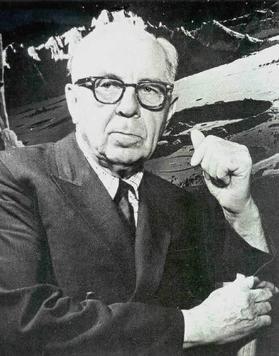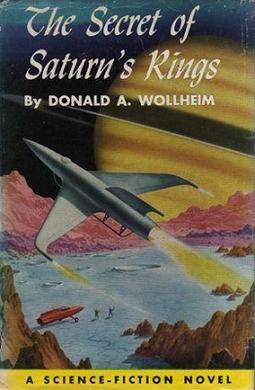
Lester del Rey was an American science fiction author and editor. He was the author of many books in the juvenile Winston Science Fiction series, and the fantasy editor at Del Rey Books, the fantasy and science fiction imprint of Ballantine Books, subsequently Random House, working for his fourth wife Judy-Lynn del Rey’s imprint, Del Rey.

Chesley Knight Bonestell Jr. was an American painter, designer, and illustrator. His paintings inspired the American space program, and they have been influential in science fiction art and illustration. A pioneering creator of astronomical art, along with the French astronomer-artist Lucien Rudaux, Bonestell has been dubbed the "Father of Modern Space art".

On April 28, 1905, William H. Pickering, who had discovered the Saturnian moon Phoebe seven years earlier, announced the discovery of a tenth Saturnian satellite, which he promptly named Themis after the Greek goddess of divine law and order. The thirteen photographic plates on which it supposedly appeared spanned a period between April 17 and July 8, 1904. No other astronomer ever confirmed Pickering's claim.

Jupiter, the largest planet in the Solar System, has appeared in works of fiction across several centuries. The way the planet has been depicted has evolved as more has become known about its composition; it was initially portrayed as being entirely solid, later as having a high-pressure atmosphere with a solid surface underneath, and finally as being entirely gaseous. It was a popular setting during the pulp era of science fiction. Life on the planet has variously been depicted as identical to humans, larger versions of humans, and non-human. Non-human life on Jupiter has been portrayed as primitive in some works and more advanced than humans in others.

Saturn has made appearances in fiction since the 1752 novel Micromégas by Voltaire. In the earliest depictions, it was portrayed as having a solid surface rather than its actual gaseous composition. In many of these works, the planet is inhabited by aliens that are usually portrayed as being more advanced than humans. In modern science fiction, the Saturnian atmosphere sometimes hosts floating settlements. The planet is occasionally visited by humans and its rings are sometimes mined for resources.
Ronald Turner was a British illustrator and comic book artist.
Hugh Walters was a British writer of juvenile science fiction novels from Bradley in the West Midlands region of the United Kingdom.
Robert Shirley Richardson was an American astronomer, born in Kokomo, Indiana. He also published science fiction using the pseudonym Philip Latham.

Moon of Mutiny is a juvenile Science fiction novel by author Lester del Rey published in 1961 by Holt, Rinehart & Winston as the final part of the Jim Stanley Series. The story takes place mostly on the Moon following the adventures of the main character Fred Halpern after he is expelled from Goddard Space Academy for insubordination, and tries to find his way back into space.

Winston Science Fiction was a series of 37 American juvenile science fiction books published by the John C. Winston Company of Philadelphia from 1952 to 1960 and by its successor Holt, Rinehart & Winston in 1960 and 1961. It included 35 novels by various writers, including many who became famous in the SF field, such as Poul Anderson, Arthur C. Clarke, Ben Bova, and Lester del Rey. There was also one anthology, The Year After Tomorrow, edited by del Rey and others. There was one non-fiction book Rockets Through Space: The Story of Man's Preparations to Explore the Universe by del Rey which details the factual science and technology of rocket flight. Many of the dust jackets became science fiction classics; the artists included Hugo Award winners Ed Emshwiller and Virgil Finlay along with Hugo nominees such as Mel Hunter and Alex Schomburg.

Rocket to Luna is a juvenile science fiction novel by prolific author and screenwriter Evan Hunter published in 1953 by The John C. Winston Company with cover illustration by Alex Schomburg. The story follows the adventures of the main character Ted Baker after he mistakenly replaces a member of the first lunar expedition at the last moment before the rocket leaves for the Moon. Rocket to Luna is a part of the Winston Science Fiction set, a series of juvenile novels which have become famous for their influence on young science fiction readers and their exceptional cover illustrations by award-winning artists.

Five Against Venus, written by Philip Latham, is a science-fiction novel first published in the United States in 1952 by the John C. Winston Company. Philip Latham was the nom de plume of Robert S. Richardson, a professional astronomer who also provided technical assistance on movies such as Destination Moon and wrote scripts for the Captain Video television series.

Planet of Light is a science fiction novel by American writer Raymond F. Jones, first published in 1953 by the John C. Winston Co. as part of its 35-book set of juvenile novels. Written as a sequel to Son of the Stars, the story follows Ron Barron and his family as they are taken to a planet in the Great Galaxy of Andromeda to participate in a meeting of an intergalactic analogue of the United Nations. They face the question if Earth is ready to join an intergalactic society.

The Secret of Saturn's Rings is a science-fiction novel by Donald A. Wollheim and was first published in the United States by the John C. Winston Company in 1954. This is the first of three novels that Wollheim wrote for the Winston Company, the other two being The Secret of the Martian Moons (1955) and The Secret of the Ninth Planet (1959).

The Secret of the Ninth Planet is a science-fiction novel written by Donald A. Wollheim and first published in the United States in 1959 by the John C. Winston Co. Wollheim takes his heroes on a grand tour of the Solar System as that team struggles to prevent an alien force from blowing up the Sun. This is the last of three juvenile novels that Wollheim wrote for Winston, the other two being The Secret of Saturn's Rings and The Secret of the Martian Moons.
The year 1952 was marked, in science fiction, by the following events.
The year 1953 was marked, in science fiction, by the following events.
The year 1954 was marked, in science fiction, by the following events.











